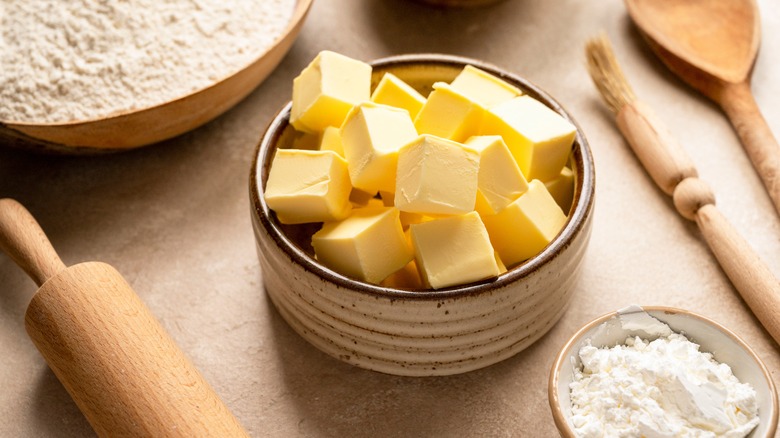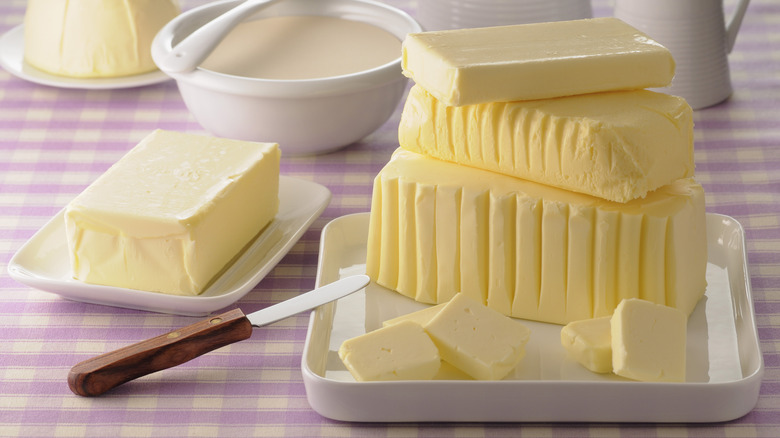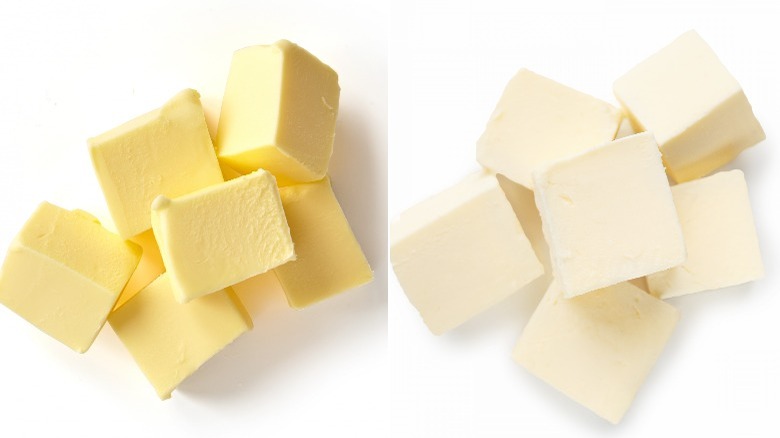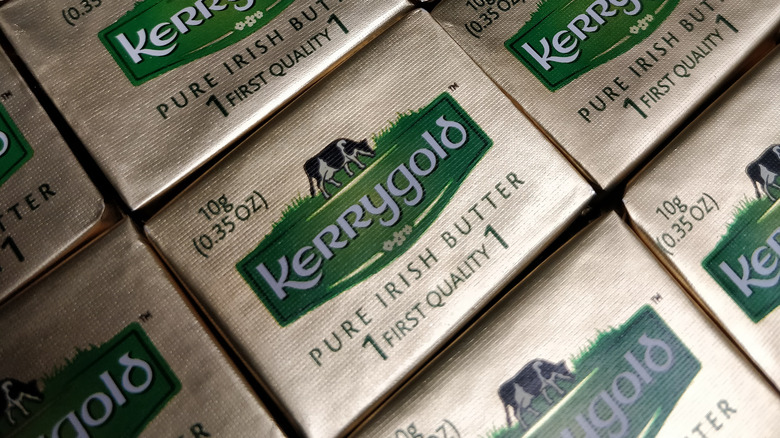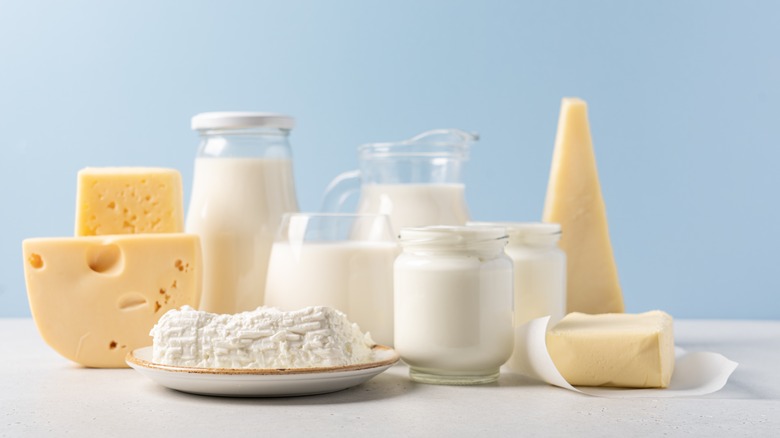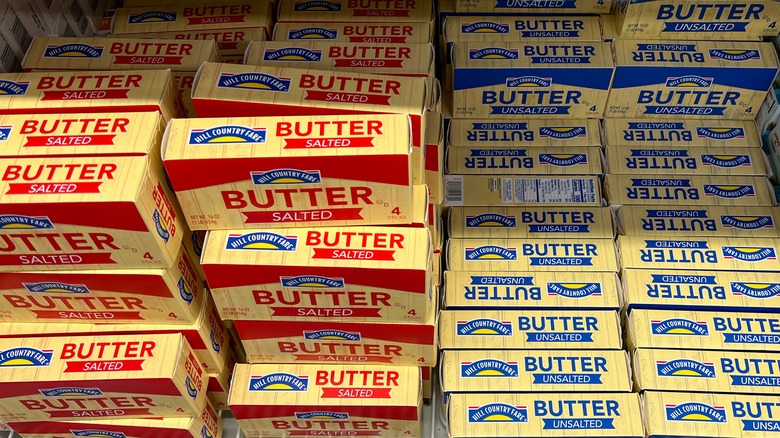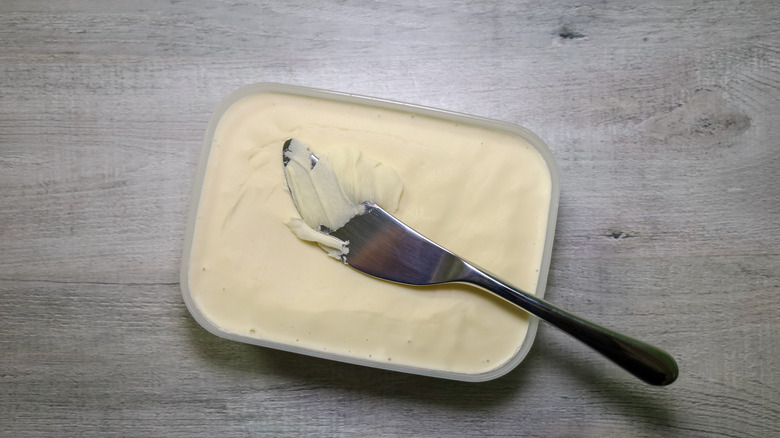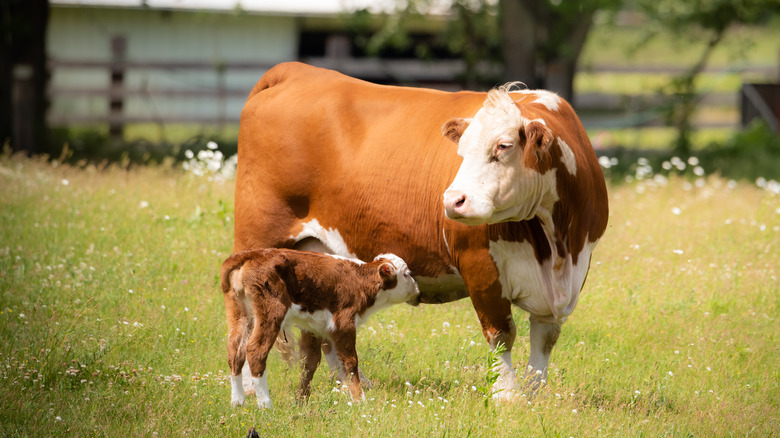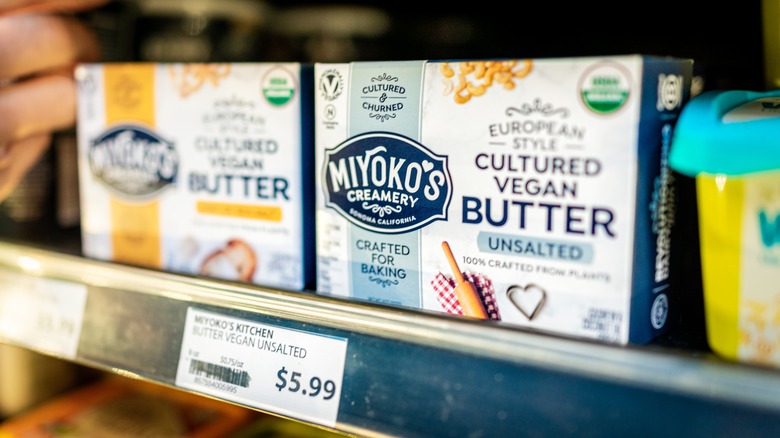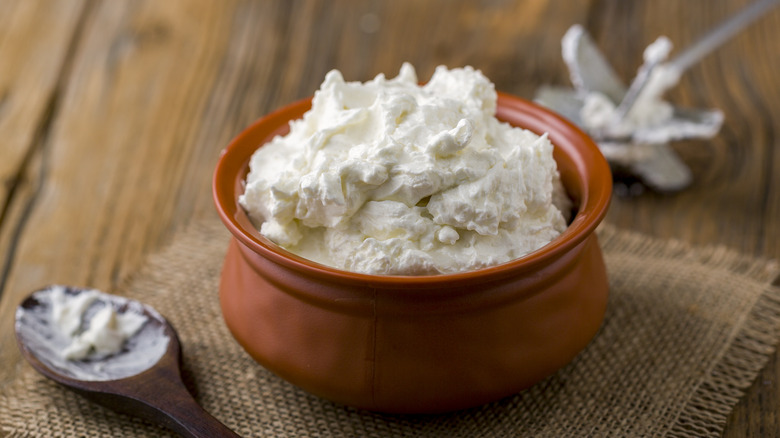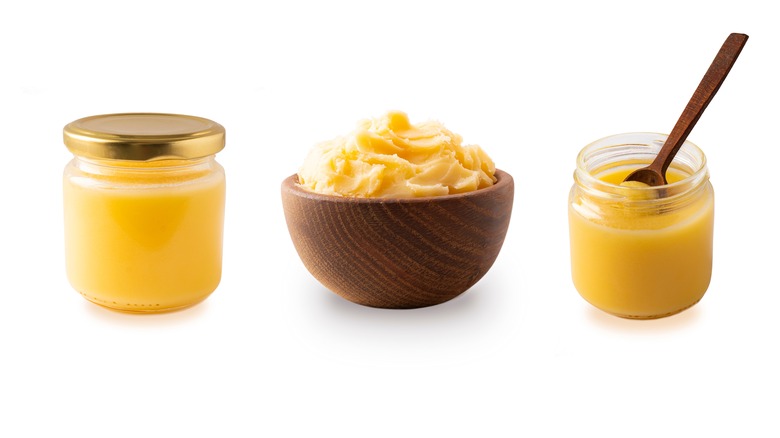The Best Tips For How To Choose Butter When Baking
Butter is magical when baking. Butter has been around for more than 10,000 years, according to the American Butter Institute. Since then, it has become "the world's most popular fat." It is no wonder why. Butter is the basis for many desserts such as puff pastry, pie crust, and the famous croissant. The butter in these desserts gives them their signature flakey texture. However, butter doesn't just add to the texture; it adds a flavor unparalleled by other fats and one that we just can't get enough of.
Butter is made by churning milk until the butterfat separates from the liquid and begins to stick together into the glorious golden substance we know and love (via Shelburn Farms). While butter consumption in America had declined due primarily to health concerns, it is again on the rise, as reported by NPR. Chef Julia Child famously loved butter and did not approve of its decline, saying, "If you're afraid of butter, use cream" (via Today). With butter's popularity, grocery stores are practically overflowing with options, which can be overwhelming. There is more than one kind of butter, and if you are trying to figure out which kind best meets your baking needs, read on.
Consider the butter's fat content
Butter is added to baked goods as a source of fat. Compared to other fats such as oil, which is liquid at room temperature, butter bakes differently than its alternative (via Land O Lakes). However, what many people don't realize is that different kinds of butter have different levels of fat in them.
According to Land O Lakes, butter in the United States has a minimum fat of 80%, with the rest being water. However, you may have noticed butter in the dairy aisle that is foil-covered such as the brand Plugra, which is listed as European-style butter. European-style butter starts at a higher fat of 82% but can go up to 84% (via Taste Cooking). While the difference of a few percent may not seem like much, for baked goods, it can make all the difference. High-fat butter is ideal for butter-forward flavors and baked goods such as croissants and pie crusts.
Look at the butter's color
Butter also comes in more than one color. While many people in the U.S. are used to the soft, pale yellow of American butter, European butter, including Irish butter, offers a far more pronounced yellow color. According to Business Insider, this is due to the levels of beta-carotene in the butter components. Beta-carotene is the same nutrient that gives vegetables such as carrots their orange color. European butter has more beta-carotene in it primarily due to the cows' diet. While in the United States, cows are predominantly fed corn, they are more likely to be grass-fed in Europe, producing higher beta-carotene milk and butter.
There is a time and a place for each butter. While deeper yellow butter can offer benefits, that particular hue may not be ideal for making things such as frosting if the end result is supposed to be pristine white. Before you choose a butter for baking, make sure to consider the aesthetics of each butter option. It is also important to note that some butter companies will add beta-carotene to butter to give it color. So when choosing a butter, be sure to check the label if you want one without added ingredients.
Consider the country of origin
We have already delved into some of the differences between American and European butter. If you are sold on the idea of using a European-style butter, go for it. Many consider it to be better tasting than its pale American alternative (via Business Insider). Some U.S. companies, like Land O Lakes, have noticed consumers leaning towards European-style butter and have begun to produce their own. These varieties are made to European butter standards, meaning they are churned to at least 82% fat and are lower in moisture than their American counterparts. This butter is perfectly suitable for baking and can be used as a butter substitute for any recipe calling for European-style butter. However, there are still some crucial differences.
As NPR and Business Insider note, Irish and European butter tends to be pasture-raised, as opposed to corn-fed like in America. This makes American butter often lower in beta-carotene, which impacts the butter's flavor and color. So if you are looking for the richness of European butter without the color, American-made European-style butter may be the best choice. However, if you want that signature rounded butter flavor, try Irish or European-made butter.
Check if it's cultured butter or not
A butter's cultured status is not based on how much Shakespeare it has read. Instead, it is based on the process used to make the butter.
If you go to the store and see butter listed as "sweet cream" butter, this is your standard American butter (via MasterClass). The name "sweet" simply denotes that the cream used to make the butter is pasteurized but otherwise unaltered. However, there is another style of butter: cultured butter. As Vermont Creamery explains, this is butter made from cream that has been mixed with cultures and fermented before the churning process. This creates a butter that is tangier than sweet cream butter.
Milkio also explains that cultured butter has a higher melting and smoking point, making it ideal for spreading on toast and any baking projects where you need to melt or cook the butter but do not want to risk burning it. Culturing butter may be the way to go if you are looking for a unique buttery flavor. However, stick with sweet cream butter if you are hoping for subtle fattiness.
Note if its salted or unsalted butter
When it comes time to bake, one of the top questions to consider is whether to use salted or unsalted butter. Much of the time, a recipe will specify if you should use salted or unsalted butter for a baking project. To add a little confusion, though, some recipes call for what they refer to as "sweet butter," which is typically unsalted butter (via Challenge Butter).
Each butter has its benefits. Salted butter, as MasterClass explains, has a longer shelf life than unsalted butter and also has a pleasant brightness to the flavor that the salt brings. However, as Land O Lakes points out, using unsalted butter gives complete control over the salt content in the recipe, which is why it is often used for baking.
If you find yourself with only one kind of butter, though, don't worry. Subsitutiting is easy. Salted butter has approximately one-quarter teaspoon of salt per stick of butter. If a recipe calls for salted butter, simply add one-quarter teaspoon salt to the recipe, and if it calls for unsalted, omit one-quarter teaspoon salt from the recipe (via Good With Butter).
Check when to use spreadable butter
To keep things interesting in the butter aisle, companies have started making "spreadable butter." Spreadable butter can be confusing, as butter at room temperature is spreadable. As Foodiosity points out, many people confuse spreadable butter with the butter alternative margarine. Land O Lakes notes that spreadable butter is made using real butter but has oil added to keep it spreadable even when cold. For example, one butter by Land O lakes uses canola oil in the mix to stay soft. This difference can affect the fat content, as well as the water content in the butter spread. On the other hand, margarine is kept at a consistent 80% fat, keeping it consistent with butter sticks.
Land O Lakes does not recommend using spreadable butter for most baking. Because it is not pure butter, using a butter spread can affect the result of your baking project. However, Land O Lakes states that it can work if there is no other choice.
Consider the difference between grass-fed and organic
If you are considering upgrading your baking butter, you have likely considered grass-fed and organic butter varieties. Typically these kinds of butter are more expensive than their conventional counterparts, but in some cases, it may be worth splurging. As NPR points out, grass-fed butter typically has a more pronounced yellow color but also has a more pronounced taste. Business Insider explains that grass-fed butter is higher in omega-3 fats, which keep the butter soft and delicious. Many people prefer it simply due to its taste.
That being said, some may prefer grass-fed and organic butter for the perceived health benefits. In addition, Healthline states that grass-fed butter offers higher levels of specific vitamins and is high in unsaturated fats. Organic butter is made without the use of hormones or antibiotics, which may be desirable (via Live Natural Magazine). While it won't affect the outcome of your baking project, if these benefits are desirable, it may be worth splurging for grass-fed or organic butter.
Look into the dairy source
When Americans think butter, they think cows. This is because most butter in the United States is made from a base of cow's milk. However, there is more than one kind of milk to make butter out of, and the different dairy sources produce slightly different butter.
The New York Times explored butter made from goat milk. It is lighter in color than cow's milk, appearing white, and offers a subtle tang similar — though less intense — to that of goat milk. Goat butter is also higher in moisture content. In their experience, this meant while it could be substituted, baked goods such as cookies did not bake quite as well with goat's butter as they did with cow's butter. Times of India notes, though, that goat butter is more nutritious than cow butter, and its lower melting point is ideal for some baked goods.
Sheep dairy company Woodlands also makes an argument for sheep milk dairy. They point out that many who are intolerant to cow or goat milk can tolerate sheep milk dairy products. They also argue that sheep milk is a healthy alternative to cow and goat milk. If you are baking something for someone with a sensitivity or allergy to cow's milk, it may be worth considering goat or sheep butter for your next baking project.
Check out non-dairy butter
If you are considering non-dairy butter, there are a few things to look out for. First, not all margarine is completely dairy free (via Land O Lakes). Many kinds of margarine can utilize a combination of oil and milk fat to create a butter-like substance. Margarine does need to be 80% fat, just like butter, which makes it suitable for baking. However, non-dairy spreads do not have the same requirements, and much like spreadable butter, they should not be used for baking (via Crafty Baking).
Luckily in recent years, the world of non-dairy butter has expanded, and there are some fantastic options now. But even with those options, there will be some differences in baking. King Arthur tested two well-known vegan kinds of butter, Miyoko and Earth Balance, to see how they baked up next to cow milk butter. They found that while they baked acceptably, both vegan kinds of butter led to slightly paler final products. While all created flakey products, the vegan butter didn't always rise as much as cow butter, and the flavor was noticeably different.
Don't forget about whipped butter
Similar to spreadable butter, whipped butter starts with a butter base but is altered to make it more spreadable (via Challange Dairy). Whipped butter starts as either salted or unsalted butter and is then whipped to incorporate more air into it. Alternatively, nitrogen gas may be used to whip it and make it light (via Webstaurant). This air makes it fluffy and easy to spread. While it is great for topping and spreading, it can not be used as a one-to-one substitute for baking sticks. Because of the added air, the whipped butter volume is different from that of a baking stick. Therefore, recipes will not turn out the same as a recipe that calls for regular butter.
However, that doesn't make whipped butter useless. If the butter is melted and used to top things such as buns, or used as a spreadable base in recipes such as cinnamon buns, then as long as you have enough whipped butter for a project, it will not affect the final result.
Mix it up with clarified butter or ghee
Finally, there is clarified butter. This butter is not always found in the dairy aisle with the rest, but instead can often be found in the cooking oil or baking section (via Milkio and Food Champs). This is because clarified butter and ghee are shelf-stable, unlike most butter products.
Clarified butter is butter that has had the milk solids and water removed, leaving pure or nearly pure butterfat (via MasterClass). This is done by melting butter over low heat, allowing the water to evaporate and the milk solids to fall to the bottom, and leaving only butterfat. Ghee, which originates in South Asia, is clarified butter but is typically cooked a little longer, giving it a toasted taste.
In addition to being shelf-stable, ghee also has a higher smoking point than regular butter, and some who are lactose intolerant are able to eat clarified butter. Because of this, MasterClass recommends it as a useful butter alternative. In addition, Joy of Baking explains that while it is typically used in cooking, clarified butter can be used in baking projects that do not require butter to be creamed and will add a slightly nutty flavor.
